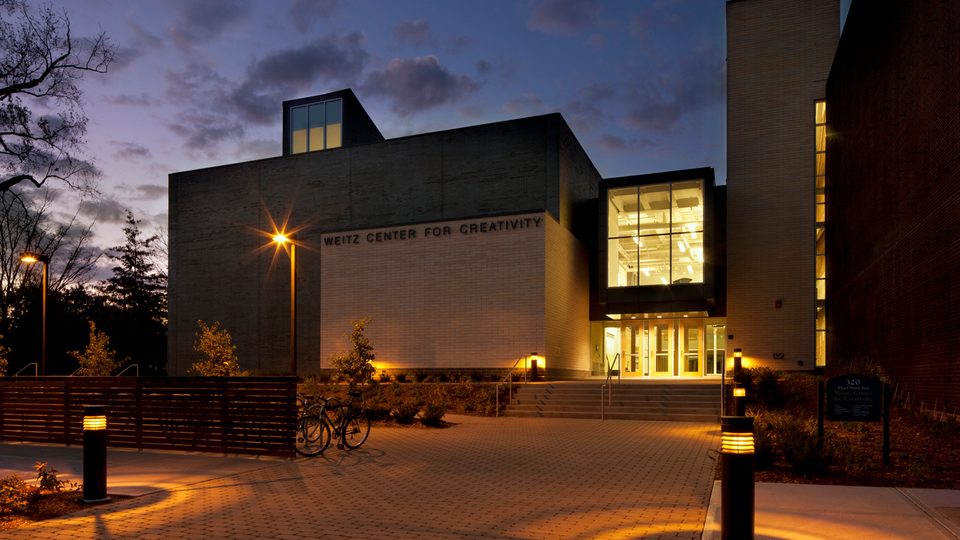Carleton College’s Weitz Center for Creativity Earns LEED® Gold Status
Carleton College’s Weitz Center for Creativity has earned LEED® Gold certification, as established by the U.S. Green Building Council and verified by the Green Building Certification Institute (GBCI). LEED (Leadership in Energy and Environmental Design) is the nation’s preeminent program for the design, construction and operation of high performance green buildings. Opened in September 2011, is Carleton’s third building to earn LEED certification. Cassat Hall and James Hall (formerly Memorial Hall), residence halls completed in August 2009, also received LEED® Gold certification.

Northfield, Minn.––Carleton College’s Weitz Center for Creativity has earned LEED® Gold certification, as established by the U.S. Green Building Council and verified by the Green Building Certification Institute (GBCI).
LEED (Leadership in Energy and Environmental Design) is the nation’s preeminent program for the design, construction and operation of high performance green buildings.
“There’s no single feature that makes the Weitz Center for Creativity a green structure,” says Steven Spehn, director of facilities and planning. “Every aspect of the building has been planned and designed in a sustainable way.”
The Weitz Center for Creativity achieved LEED certification for energy use, lighting, water and material use as well as incorporating a variety of other sustainable strategies. By using less energy and water, LEED certified buildings save money for families, businesses and taxpayers; reduce greenhouse gas emissions; and contribute to a healthier environment for residents, workers and the larger community. “While it may cost more to apply for and obtain LEED certification, we believe that College gets real value in reduced operating costs and lower carbon emissions over the long run” says Fred Rogers, vice president and treasurer of the College. “LEED Gold seems to be a good balance between the costs and benefits of the program, for us.”
Opened in September 2011, is Carleton’s third building to earn LEED certification. Cassat Hall and James Hall (formerly Memorial Hall), residence halls completed in August 2009, also received LEED® Gold certification.
The design-build project was led by McGough Companies and designed by Meyer Sherer & Rockcastle, LLC. The team was directed to produce a highly energy-efficient building while meeting the program of large performance spaces and classrooms with rapidly changing occupancies and demanding acoustic, temperature and humidity requirements.
LEED certification of the Weitz Center for Creativity was based on a number of green design and construction features that positively impact the project itself and the broader community. These features include:
- Preservation and restoration of large portions of the original Northfield Middle School building
- Repurposing of materials, including original woodwork, flooring, trim and blackboards
- Local sourcing of materials whenever practical
- Recycling or reuse of construction materials to keep them out of landfills
- Energy-efficient improvements, including new insulation and replacement windows
- Water-efficient plumbing, landscaping, and irrigation systems
- Low-emission paints, adhesives, and carpeting
From its earliest inception, the Weitz Center for Creativity was imagined as much more than an arts building. While it does create much-needed new exhibit and performance spaces, the building’s true mission is to serve as a working laboratory for creativity––not only in the arts, but across the entire curriculum. Carleton’s vision for the Weitz Center is an interdisciplinary workshop that transforms how the College teaches and learns. It is an innovative facility that fosters creative collaboration, reaching across all academic disciplines at Carleton—and beyond campus, into the larger academic and arts communities. It contains centralized support for multimedia and interactive technologies.
From video and sound editing facilities to digital libraries and computer labs, the Weitz Center for Creativity brings together both the equipment and the expertise that student and faculty need to make the most of new technology and media. The building houses uniquely flexible multipurpose spaces for teaching, performing, working and creating. Theater seating can be reconfigured to accommodate a traditional proscenium, a thrust stage, or whatever a production requires; the dance studio can do double duty as performance space; the art museum facilitates teaching as well as exhibits; “white space” areas can accommodate anything from a visiting lecturer to a robotics class. New and unexpected combinations of faculty and staff teach and interact with students under the same roof, some permanently, others for a residency period. Art meets physics; music meets math; traditional academic boundaries are set aside to create interdisciplinary partnerships in teaching and research. Finally, community spaces encourage both impromptu and planned gatherings of students, faculty, neighbors and visitors.
The name of the Weitz Center for Creativity reflects the contributions made by the family of Wally (’70) and Barbara (’70) Weitz, their children Katie (’96), Roger (’99), and Drew (’02), and their spouses Watie White (’93), Kate, and Meredith (’02), who together contributed $15 million towards the completion of the facility.